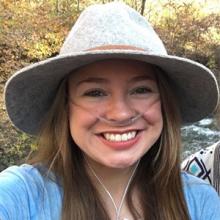When I became a brand ambassador for American Eagle’s loungewear line, Aerie, last summer, I felt so honored to represent the cystic fibrosis community, feeding tube community, and the transplant community.
Like super-duper amazing! You have to apply to become a part of this body-positive group of brand ambassadors. I have always loved Aerie’s mission about body positivity and loving yourself just the way you are. Some things that many of us with CF struggle with are the changes to our body that this disease and the medications it requires can cause. Bloating, water retention, hair loss, bruising, and skin breakouts are common issues that can occur.
One prevalent and unfortunate thing that changed my body is a side effect from the medication Prednisone. It is known to have many side effects, especially “moon face.” “Moon face” is what happens when you're put on a high dose of prednisone for a long period of time. People who have had a transplant, like me, are on this medication for life! My face blew up because of the high doses I was on when I first received my double-lung transplant. My face was huge and I had large chipmunk cheeks that I personally didn’t think were very cute. I became super self-conscious about my face, and I knew it would not be going away any time soon. For some people it can last longer, but mine started to go back to normal after a year. Any picture I took, that’s all I could see. I even had some people comment on pictures asking what happened to my face, which I thought was rude.
Another common and unavoidable side effect from prednisone is weight gain because it increases your hunger. I started on it months before my transplant and I could tell there was a difference in my face and body. It’s a big adjustment when you’re used to being super skinny and bony, and then your body starts to change and becomes bigger — even if gaining weight is a good thing for you.
Surgeries and sickness lead to scars and medical devices. Over the years I had become very accustomed to having IV tubing and dressing as part of my daily outfit. For several years I was constantly in and out of the hospital doing home IVs. Even without the IV, my portacath was often visible depending on the season and what I was wearing. I have had many people ask me about it. Some knew what it was and would ask how long I've had my port, or assume I had cancer because it’s common for cancer patients to have one for chemotherapy infusions.
Over the years I have accumulated several scars from surgeries, ranging from small to large. I have a handful of small ones on my stomach. I have two small ones from having a portacath. I no longer have the device — they took that out in 2018 because I got sepsis. My largest scar came from my double-lung transplant. The incision is called a clam shell which goes from near under my armpit, under my chest, and to the other armpit. This is a scar you can see when I wear a bathing suit or wear a certain type of top. I’ve never been ashamed of or embarrassed by my scars. I call them my battle scars!
2007 is when I made the decision to get a feeding tube, which is a medical device in my stomach. It was more of an ultimatum in which I decided to embrace the “I want to survive” mindset. I was a junior going into my senior year of high school. The first summer following the surgery I was quite self-conscious of having this little piece of silicone in my stomach. I just had a feeling that everyone would be staring at me. I wasn’t wrong about that, a lot of people did. Some even pointed while talking to the person they were with. Some people had come up to me and asked what it was, or assumed it had something to do with diabetes. It bugged me at first, but after a while I got used to it. I decided I wasn’t going to care what the heck people thought about me any longer. I was never going to see those people again. I even stopped noticing people looking at me. Something else that I decided was that I was going to use those instances as an opportunity for awareness for CF and feeding tubes.
Wearing oxygen on my face is something that I also had to get used to. I was resistant about wearing mine in public at first, but my need to breathe was bigger than what I thought people would think of me. Oh, and I can’t forget needing to be pushed around in a wheelchair. The year leading up to my transplant, it was hard to even walk several steps without needing to stop to catch my breath or have a cough attack. My sister, Laima, who was my caregiver, would push me around when I needed the extra help.
Having CF with the IVs, oxygen on my face, sitting in a wheelchair, transplant scars, medication side effects, and a feeding tube have made me someone who does not give a flying hoot about what people think of how I look.
This body of mine has gotten me through some hard challenges and has gotten me to where I am today. I survived end-stage disease and a double-lung transplant. I am proud of the body I have. I work hard to maintain my “new” shiny lungs with weekly workouts, hikes, and snowboarding.
Accepting your body for the way it is can be hard, but not impossible.
Interested in sharing your story? The CF Community Blog wants to hear from you.


